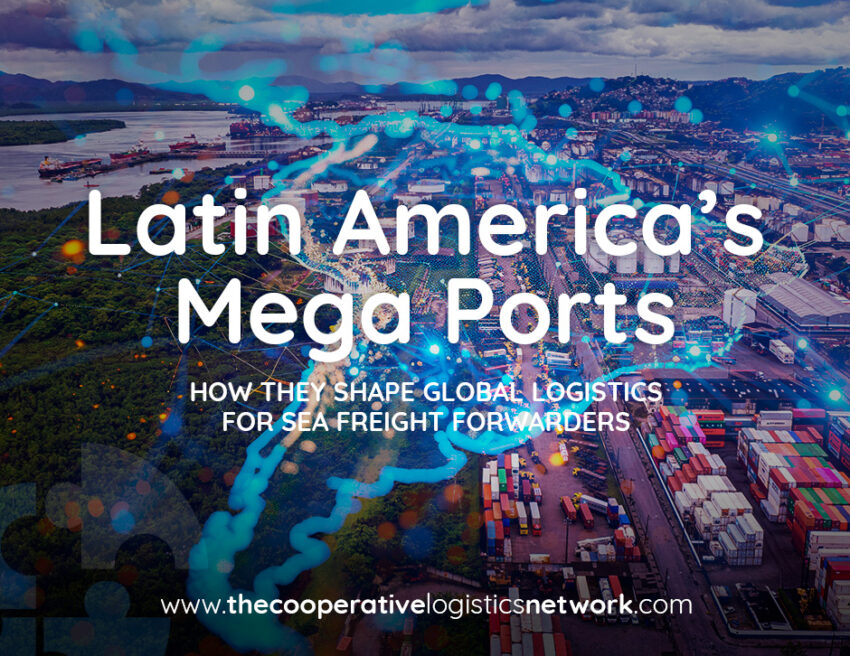Latin America is home to some of the most dynamic and strategically positioned ports in the world, serving as crucial trade arteries connecting international markets. These mega ports are not only transit hubs but also serves as the backbone of global supply chains, driving economic growth and facilitating commerce across continents. As cross-border trade intensifies, the efficiency and capacity of these ports become even more critical for logistics company relying on seamless cargo movement. For sea freight forwarders, mastering the complexities of Latin America’s major ports is a game-changer, offering opportunities to optimize logistics, reduce transit times, and enhance service reliability.
For sea freight forwarders, leveraging the strengths of these ports can result in more cost-effective and streamlined operations. Some of the key benefits of Latin America’s mega ports include access to both the Atlantic and Pacific Oceans, efficient multimodal transport connections, competitive shipping costs, and expanding capacity to accommodate larger vessels.
In this article we will take a deep dive into the region’s top ports, exploring their significance and the essential role they play in shaping the future of sea freight forwarding.
Top Mega Ports in Latin America

Latin America has several high-capacity ports that significantly influence global trade. Below are some of the most important ones for sea freight forwarders.
Port of Santos, Brazil
The Port of Santos is the busiest port in Latin America and serves as Brazil’s primary trade hub. It handles a diverse range of cargo, including agricultural products, machinery, and chemicals. With an annual throughput of over 4.4 million TEUs, it maintains strong trade connections with China, the U.S., and Europe. For sea freight forwarders in Brazil, Santos provides access to Brazil’s vast export market, particularly soybeans, coffee, and sugar.
Port of Manzanillo, Mexico
Located on Mexico’s Pacific coast, the Port of Manzanillo is the country’s most crucial container port, handling nearly half of its maritime cargo. With an annual throughput of around 3.5 million TEUs, it maintains key trade relations with Asia, the U.S., and South America. Manzanillo offers efficient connections to inland Mexico, making it a prime entry point for goods destined for North America.
Port of Balboa, Panama
Strategically positioned at the entrance of the Panama Canal, the Port of Balboa is a major transshipment hub connecting the Atlantic and Pacific trade routes. With an annual throughput of approximately 2.5 million TEUs, it plays a crucial role in facilitating trade between the U.S., China, and South America. The port’s proximity to the Panama Canal allows for seamless cargo movement between major global markets, making it an essential hub for sea freight forwarders.
Port of Cartagena, Colombia
One of the most technologically advanced ports in Latin America, Cartagena is a key gateway for Colombian exports and transshipment operations. It handles over 3 million TEUs annually and maintains trade relations with North America, the Caribbean, and Europe. Its efficiency and advanced infrastructure make it a preferred choice for shippers moving cargo through the region.
Port of Callao, Peru
As Peru’s main commercial port, Callao is essential for trade in the Pacific region, handling a variety of containerized and bulk goods. It has an annual throughput of over 2.8 million TEUs and serves key trade partners in Asia, Europe, and North America. Callao’s growing infrastructure investments enhance its capabilities, making it an attractive hub for South American trade.
Challenges Facing Latin American Ports and Sea Freight Forwarders
Despite their strengths, Latin America’s mega ports face several challenges that sea freight forwarders must navigate to maintain efficiency. One major issue is port congestion, as increasing trade volumes have led to delays and higher logistics costs. Infrastructure gaps also present obstacles, as some ports have invested in modernization while others still struggle with deficiencies affecting overall efficiency. Regulatory complexities further complicate operations, as customs procedures and trade regulations vary across Latin American countries, requiring forwarders to stay updated on compliance requirements. Additionally, environmental considerations are becoming increasingly important, with sustainability playing a major role in shaping future shipping operations as ports adopt greener practices to reduce their environmental impact.
Future Trends in Latin American Port Development
To remain competitive, Latin America’s mega ports are embracing technological advancements and strategic initiatives. Sea freight forwarders can benefit from these developments by leveraging improved efficiency and service offerings. Port automation and digitalization are revolutionizing operations, with automated cargo handling, digital tracking, and blockchain technology streamlining processes. Several ports, including Santos and Manzanillo, are expanding their capacity to accommodate larger vessels and higher trade volumes. Sustainability initiatives are also becoming more prevalent, with green port measures such as shore power and energy-efficient cranes being adopted to meet global environmental regulations.
Conclusion
Latin America’s mega ports are indispensable to global logistics, offering key trade routes and advanced infrastructure to facilitate seamless cargo movement. For sea freight forwarders, understanding the capabilities and challenges of these ports is crucial for optimizing supply chains, reducing costs, and enhancing operational efficiency. As port developments continue to evolve, freight forwarders must stay ahead of industry trends to maximize opportunities in this vital region of global trade.


